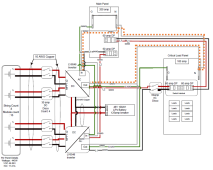bertiojones
New Member
- Joined
- Feb 14, 2022
- Messages
- 90
(Moved to appropriate forum area)
Hi all!
Looking for some feedback on this build before I start spending money.
Couple of things to explain out the gate. I have DC Disco and AC Disco to help with passing inspection. Inspectors love quick safety disconnects with signage otherwise I would just be using a combiner with breakers as the disconnect. (Should I still use a breaker/combiner box for protection?)
Also I will be using a switched interlock on the Critical Load Panel to bypass the Inverter for maintenance and feed grid back to that panel. The Interlock is UL listed by Eaton. Critical Load Panel will be 1 foot to the right of the main panel and have loads extended into it. Loads will be everything in my house minus large loads like dryer and A/C (for now)
Three biggest things I am unsure of...
1) Panels sizing. Running 4 strings seems silly for 7.12kw of solar but running all 4 MPPT's and having less panels seems like the way to go cost wise. Less panels, less racking (Will be roof racked). I am seeing that 250 VOC on the LV6548 is an odd spot for panels and that 320 watt panels are a sweet spot. But even then now your adding another 6 panels for the same amount of solar and increasing your amps and therefore wiring gauge. So to me it seems odd but my math checks out so let me know if I am missing something. It would be nice not to use up all 4 MPPT's in case I wanted to expand but I guess thats what a separate MPPT on the battery is for.
2) The runs will be Main Panel - 50 feet - Inverter - 50 feet - Critical Load Panel. Manual asks for 4AWG (I would run 6/3 or 4/3) for the input and output but I am reading people are barely able to get 6AWG to fit in the terminals. With my distance of 50 feet would the volt drop be high enough to warrant 4AWG? If so how would I make it fit in the terminal? I don't mind the cost I just want to do it right the first time. Either way its going to be $400-$600 in cable for both 50 foot runs.
3) Fusing on the battery. I am seeing running individual 150 amp fuses for each Inverter. My brain is thinking if I am only using EG4 batteries with their own OCP of 125 amps adding another fuse seems redundant. Tell me if I am wrong. Also I will be adding up to 6 of those batteries together eventually down the road once the system is working. The battery sizing part seems the easiest to expand as needed.
Thanks for all your time!
(I attached the blueprint inline and for download)

Hi all!
Looking for some feedback on this build before I start spending money.
Couple of things to explain out the gate. I have DC Disco and AC Disco to help with passing inspection. Inspectors love quick safety disconnects with signage otherwise I would just be using a combiner with breakers as the disconnect. (Should I still use a breaker/combiner box for protection?)
Also I will be using a switched interlock on the Critical Load Panel to bypass the Inverter for maintenance and feed grid back to that panel. The Interlock is UL listed by Eaton. Critical Load Panel will be 1 foot to the right of the main panel and have loads extended into it. Loads will be everything in my house minus large loads like dryer and A/C (for now)
Three biggest things I am unsure of...
1) Panels sizing. Running 4 strings seems silly for 7.12kw of solar but running all 4 MPPT's and having less panels seems like the way to go cost wise. Less panels, less racking (Will be roof racked). I am seeing that 250 VOC on the LV6548 is an odd spot for panels and that 320 watt panels are a sweet spot. But even then now your adding another 6 panels for the same amount of solar and increasing your amps and therefore wiring gauge. So to me it seems odd but my math checks out so let me know if I am missing something. It would be nice not to use up all 4 MPPT's in case I wanted to expand but I guess thats what a separate MPPT on the battery is for.
2) The runs will be Main Panel - 50 feet - Inverter - 50 feet - Critical Load Panel. Manual asks for 4AWG (I would run 6/3 or 4/3) for the input and output but I am reading people are barely able to get 6AWG to fit in the terminals. With my distance of 50 feet would the volt drop be high enough to warrant 4AWG? If so how would I make it fit in the terminal? I don't mind the cost I just want to do it right the first time. Either way its going to be $400-$600 in cable for both 50 foot runs.
3) Fusing on the battery. I am seeing running individual 150 amp fuses for each Inverter. My brain is thinking if I am only using EG4 batteries with their own OCP of 125 amps adding another fuse seems redundant. Tell me if I am wrong. Also I will be adding up to 6 of those batteries together eventually down the road once the system is working. The battery sizing part seems the easiest to expand as needed.
Thanks for all your time!
(I attached the blueprint inline and for download)





